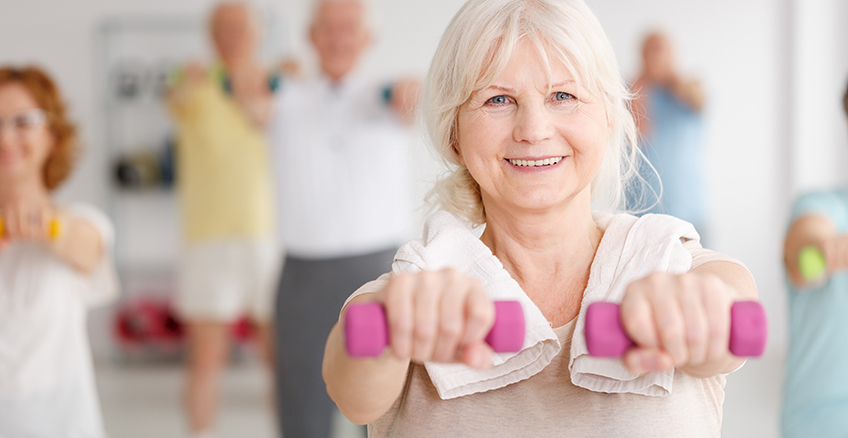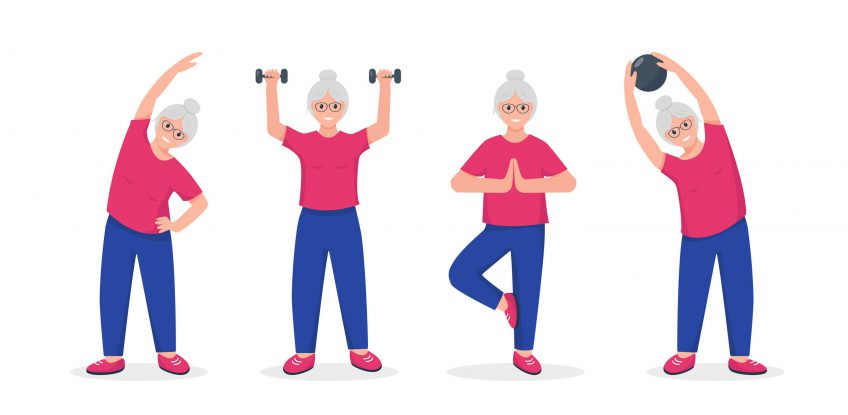
Falls prevention strategies for at home
Falls at home is a common cause of injury, particularly for people over 65. More than 270 people are hospitalised in Australia every day due to falls.[1] Many of these falls could have been prevented.
Fortunately, there are plenty of things you can do to help falls prevention at home.
The Friendlies Physiotherapists are skilled at identifying fall risks, developing falls prevention programs and supporting people who have had falls to return to physical activity.
Read on to learn more about the causes of falls, why getting active is a key falls prevention strategy, and other tips for staying safe while moving around at home.

Causes of falls
If you are prone to falls, have difficulty balancing, or have impaired mobility, being aware of the main factors contributing to falls is a critical first step toward falls prevention.
Studies show that falls requiring hospitalisation are more common in older people and are more likely to happen at home.[2] If you’re prone to falls or feeling unsteady on your feet, it’s a good idea to see your doctor and have your home audited to identify existing hazards.
Common causes of falls include:
- Slipping, tripping or stumbling on a level surface
- Falling on or from stairs, rails or ramps
- Falling from stools or ladders
- Falling from or tripping on furniture, especially beds and chairs
- Muscle weakness
- Balance problems
- Foot problems
- Dizziness, light-headedness or changes in blood pressure
- Medication or alcohol
- Vision or hearing problems
Falls prevention: strategies for managing falls risks
When looking at falls prevention, we must consider factors that increase the risk of falling. It’s helpful to be aware of the intrinsic and extrinsic factors that are known to elevate the risk and what you can do about it.
Firstly, let’s look at intrinsic factors which are specific to YOU.
| Intrinsic factors that increase the risk of falling | Falls prevention strategy |
| Increased age | Ensure to stay active to reduce the effects of ageing. |
| History of falls | Decrease the risk of future falls by having a risk assessment and a supervised exercise plan. |
| Chronic medical conditions (eg. Stroke, Parkinson’s Disease, arthritis, diabetes, depression, low blood pressure, incontinence) | Appropriate medical management and individualised treatment plan. |
| Multiple medications | Speak to your doctor if you are concerned about your medications. |
|
Physical factors such as impaired balance and mobility, reduced muscle strength, low levels of physical activity and slow reaction time |
Research shows that exercise at any age is beneficial. Be active to improve your physical capacity, reaction time, strength and endurance. |
| Dizziness | Gain the appropriate assessment to determine the cause of dizziness and manage it appropriately. |
|
Sensory problems including impaired vision and peripheral neuropathy |
Review with the appropriate person for management (optometrist) or speak to your GP for guidance. |
| Impaired cognition | Keep mentally active with puzzles, word finders, brain teasers and other activities that challenge your brain. |
| Fear of falling | Improved confidence through a supervised exercise plan. |
Secondly, let’s consider the extrinsic factors which are specific to your SURROUNDINGS.
| Extrinsic factors that increase the risk of falling | Falls prevention strategy |
| Inappropriate footwear, for example, socks or loose-fitting shoes (slippers or thongs) | Wear shoes that are comfortable and fit well – they should be wide enough in the toe area, have low or no heels and have slip-resistant soles. |
| Trip and slip hazards including loose carpets, unsecured floor coverings and slippery surfaces | Repair or replace carpets with worn areas, holes or long threads. Check mats and rugs are secure and have no tears or wrinkles. Put adhesive strips on all mats and rugs. Install grab rails in the bathroom (towel rails are not usually strong enough to use as grab rails). Wipe up spills immediately and keep bathroom floors dry. Avoid wearing long clothing that touches the floor. |
| Poor lighting | Have good lighting, especially between the bed and the bathroom or toilet and near internal steps. Use plug-in night lights and movement-sensitive lights near the stairs and the bathroom. |
| Furniture | Ensure chairs and beds are sturdy and easy to get into and out of. Check tables and benches do not have sharp corners. |
|
Steps and stairs |
Install support rails or handrails. |
| Clutter | Remove clutter and make sure walkways and corridors are kept clear. |
|
Paths, footpaths and exterior steps |
Keep paths well swept. Remove mosses, fungi and lichen that make paths slippery when wet. Install grab rails next to steps that do not have handrails. Ensure outside steps are well lit and mark the leading edge (for example, with white paint) so they’re easy to see. Repair broken, uneven or cracked paths and other walking surfaces. Report cracked footpaths to your local council. |
| Garden and yard | Put garden tools away after use. Avoid using ladders, or ask someone for assistance if you need to access something at height. |
| Equipment and walking aids | Talk to a physiotherapist about whether you need a walking aid, such as a stick or a frame. This can make you more stable and improve your confidence when walking. You may only need an aid for a while until you get stronger and feel steadier. |
Getting active for falls prevention
Physical activity and the right exercises are essential for building balance, strength and flexibility. Keeping your muscles strong and joints flexible supports your body to move more safely wherever you are.
Friendlies Physiotherapy & Allied Health supervised Falls Prevention and Exercise Program is a great starting point for improving physical health. Classes are fun, tailored to your needs and held four times a week. Our Physiotherapist can also help design an exercise program that suits you.
3 exercises to help prevent falls
The right exercises to help prevent falls for you will depend on any current medical conditions, your fitness level and whether you’ve had a recent history of falls.
The most effective exercises to help prevent falls are balance exercises and those that build strength. We’ve outlined three of the most beneficial below.
1. Knee raises/knee lifts
Helps with: climbing stairs, getting out of cars and buses, and balance.
How to:
- Place your fingertips on something solid such as a countertop
- Lift one knee to hip level and hold for 5-8 seconds (start slow and increase the time held as confidence increases)
- Repeat with the other leg
- Alternate legs until you have repeated the action five times on each leg.
2. Sit to stand
Helps with: Getting out of a chair, bed or car and going to the toilet. It also strengthens core muscles, lower back muscles and legs.
How to:
- Use a stable chair with arms, such as a dining chair.
- Sit in the chair with knees at a 90-degree angle and feet placed flat on the floor, hip-width apart
- Stand up slowly by pushing into the heels and contracting the abdominal muscles, initially using the arms of the chair for support.
- Return to a seated position slowly, using the armrests for support
- As you become stronger, use one arm of the chair for support and then progress to doing the exercise with arms crossed across your chest.
- Repeat 10 times.
3. Heel raises/calf raises
Helps with: balance, strengthening calf muscles and ankles, walking, and climbing stairs.
How to:
- Stand upright and place your fingertips on something solid such as a countertop for balance.
- Lift both heels off the floor at the same time.
- Hold the position for five seconds, then slowly lower.
- Repeat five times.
We recommend seeing a Physiotherapist or Exercise Physiologist before getting started with a falls prevention or balance exercises program.
What to do if you fall
If you fall:
- Give yourself time to calm down. Catch your breath and compose yourself after the shock.
- Check your body. If you are not severely injured, you can think about getting up. If you are injured, for example with a broken bone, stay where you are and put your plan to get help into action.
- If you are not injured, look around for a sturdy piece of furniture (preferably a chair).
- Roll onto your side.
- Crawl or drag yourself over to the chair.
- From a kneeling position, put your arms up onto the seat of the chair.
- Bring one knee forward and put that foot on the floor.
- Push up with your arms and legs, and pivot your bottom around.
- Sit down. Rest before trying to move.
Rest at any time, and if you do not succeed the first time, rest and try again.
Click here to learn more about our Falls Prevention and Exercise Program for seniors.
First published 10 May 2021, updated 27 May 2022.
[1] QLD Government, QLD Health, Falls Statistics – Stay on your feet, updated 5 March 2021.
[2] Australian Government, Australian Institute of Health and Welfare, Injury in Australia: Falls, 9 December 2021.